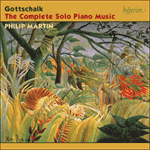Henry Rowley Bishop (1786–1855), composer, conductor and the first musician to be honoured with a knighthood (1842), wrote this imperishable air in 1821. The title of the song was then ‘To the Home of My Childhood’ with words by Thomas Bayly, and it was composed as ‘a Sicilian air’ in order to complete a collection entitled
Melodies of Various Nations. Bishop subsequently used the tune—and used it frequently—in his opera
Clari or The Maid of Milan (1823), with its now familiar lyric by the American actor and playwright (latterly a diplomat) John Howard Payne (1791–1852). Gottschalk appears to have first played an arrangement of ‘Home, Sweet Home’ in Boston as early as 1853, though doubtless it differed from this final version published eleven years later. It is dedicated to ‘Madame Mary Eugénie Martin (née Curlett) of Baltimore’, one of whose daughters was, at the time, rumoured to be infatuated with Gottschalk. The right hand of the final variation is marked celeste. Gottschalk was still playing the work six months before his death. The
Daily Alta California of 1 June 1865 reported that while playing it to an all-male audience of tough-looking miners, many broke down in sobs because the piece caused their minds ‘to wander back to the spot of their birth’.
from notes by Jeremy Nicholas © 2005
Compositeur, chef d’orchestre et premier musicien à avoir été créé chevalier (1842), Henry Rowley Bishop (1786–1855) écrivit cet air de chanson impérissable en 1821, sur des paroles de Thomas Bayly. D’abord baptisée «To the Home of my Childhood», cette chanson fut composée sous forme d’«air sicilien» pour compléter un recueil intitulé
Melodies of Various Nations. Puis Bishop utilisa cet air—et l’utilisa souvent—dans son opéra
Clari or The Maid of Milan (1823), où il l’associa au texte désormais fameux de l’acteur/dramaturge (et futur diplomate) américain John Howard Payne (1791–1852). Selon toute vraisemblance, Gottschalk joua «Home, Sweet Home» à Boston dès 1853, mais dans un arrangement sans doute différent de la présente version définitive publiée onze ans plus tard et dédiée à «Madame Mary Eugénie Martin (née Curlett) of Baltimore», dont l’une des filles s’était, selon la rumeur de l’époque, entichée de lui. La main droite de la dernière variation est marquée celeste. Gottschalk jouait encore cette œuvre six mois avant sa mort. Le
Daily Alta California rapporta cette anecdote: alors qu’il l’interprétait devant un public de mineurs aux allures de durs à cuire, nombre de ces derniers fondirent en sanglots tant ce morceau renvoyait leur esprit «à leur coin de naissance».
extrait des notes rédigées par Jeremy Nicholas © 2005
Français: Hypérion
Dieses unverwüstliche Lied schrieb 1821 Henry Rowley Bishop (1786–1855), Komponist, Dirigent und der erste Musiker, der in den Adelsstand erhoben wurde (1842). Das Lied auf Worte von Thomas Bayly hieß damals „To the Home of My Childhood“ [Über das Heim meiner Kindheit]. Komponiert war das Lied wie ein „sizilianisches Air“ und schloss eine Sammlung mit Namen
Melodies of Various Nations [Melodien verschiedener Völker] ab. Bishop zog später die Melodie wieder heran, und das ausgiebig, in seiner Oper
Clari or The Maid of Milan [Clari oder die Jungfrau von Milan] (1823). In der Oper erklang die Melodie auf dem nunmehr bekannten Text des amerikanischen Schauspielers und Schriftstellers (und am Ende Diplomat) John Howard Payne (1791–1852). Gottschalk scheint schon 1853 in Boston zum ersten Mal eine Bearbeitung von „Home, Sweet Home“ gespielt zu haben. Zweifellos unterschied sich diese Bearbeitung von der elf Jahre später veröffentlichten, hier eingespielten letzten Fassung. Sie ist „Madame Mary Eugénie Martin (geborene Curlett) of Baltimore“ gewidmet. Eine ihrer Töchter war damals angeblich in Gottschalk verliebt. Die rechte Hand in der letzten Variation enthält den Hinweis celeste. Gottschalk spielte dieses Werk noch sechs Monate vor seinem Tod. Die Zeitung
Daily Alta California berichtete am 1. Juni 1865, dass viele im Publikum, das ausschließlich aus hart gesotten aussehenden Grubenarbeitern bestand, in Tränen ausbrachen, weil sie das Stück an den „Platz ihrer Geburt“ erinnerte.
aus dem Begleittext von Jeremy Nicholas © 2005
Deutsch: Elke Hockings


 Gottschalk: The Complete Solo Piano Music
Gottschalk: The Complete Solo Piano Music
